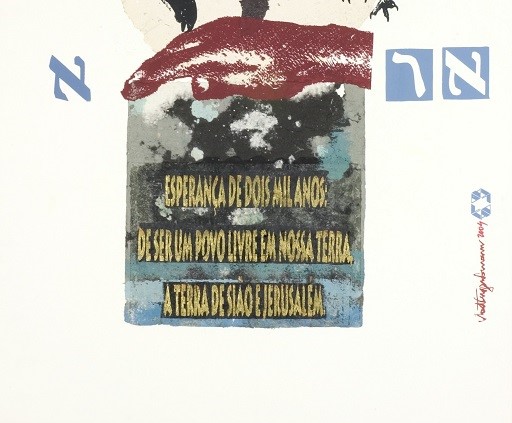On the creation of Porto Alegre's Jewish character in Michel Laub's Diary of the fall
DOI:
https://doi.org/10.35699/1982-3053.2023.46483Keywords:
Creative Writing, Jewish Literature in Porto Alegre, Diary of the fallAbstract
This article aims to analyze the creation of the Jewish character from the city of Porto Alegre in the novel Diary of the fall by Michel Laub (2011) considering the character’s cultural background and the importance of Judaism and Porto Alegre to the narrative. By referencing studies on character creation by Luiz Antonio de Assis Brasil (2019) and James Wood (2017) and, on Jewish identity, by Moacyr Scliar (1985), Elizabeth Roudinesco (2010), and Amós Oz and Fania Oz Salzberger (2015), the article investigates the way in which the novel’s character relates to intergenerational interaction, as well as to individual and collective traumas. It also reflects on the role of writing in transmitting Judaism across the three generations of men in the character’s family.
Downloads
References
ALEICHEM, Sholem. Stempenyu: um romance judaico.Tradução de Adriana de Oliveira. São Paulo:Grua Livros, 2014.
ALVAREZ, Justin. What We’re Loving: Communism, Climates, Cats. The Paris Review. Disponível em: https://www.theparisreview.org/blog/2014/04/11/what-were-loving-communism-climates-cats/. 2014. Acesso em: 14 nov. 2022.
ARISTÓTELES, A poética.Tradução de Paulo Pinheiro. São Paulo: Editora 34, 2017.
ASSIS BRASIL, Luiz Antonio de. Escrever ficção. São Paulo: Companhia das Letras. 2019.
BACHELARD, Gaston. A poética do espaço. In: PESSANHA, José Américo Motta (Org.). Os pensadores: Bachelard. Tradução de Antônio da Costa Leal e Lídia do Valle Santos Leal. São Paulo: Abril Cultural, 1978.
BLOCKER, Merrie D. A criação deNuma clara manhã de abril, de Marcos Iolovitch, no contexto histórico. Tradução de Luciano Ariel Gomes. Webmosaica. Revista do Instituto Cultural Judaico Marc Chagall, Porto Alegre, v. 9, 2017.
BRENDLER, Guilherme. “Michel Laub se rende ao judaísmo pela primeira vez”. Folha de S. Paulo, São Paulo, 19 mar. 2011. Disponível em: https://www1.folha.uol.com.br/fsp/ilustrad/fq1903201119.htm. Acesso em: 27 out. 2022.
BRUMER, Anita. Identidade em mudança: pesquisa sociológica sobre os judeus do Rio Grande do Sul.Porto Alegre: Federação Israelita do Rio Grande do Sul, 1994.
FREY, Luisa. “Tudo num livro é autobiográfico”, diz Michel Laub. DW, [S. l.], 15 out. 2013. Disponível em: https://www.dw.com/pt-br/tudo-num-livro-%C3%A9-autobiogr%C3%A1fico-diz-michel-laub/a-17158067. Acesso em: 24 set. 2022.
GUTFREIND, Ieda. Judeus no sul do Brasil, Porto Alegre-RS: da dispersão grupal à construção institucional e comunitária. In: LEWIN, Helena (coord). In: Identidade e cidadania: como se expressa o judaísmo brasileiro[online]. Rio de Janeiro: Centro Edelstein de Pesquisas Sociais, 2009, p. 80-96.
IGEL, Regina. Escritores judeus brasileiros: um percurso em andamento. Revista Iberoamericana, [S. l.], v. LXVI, n. 191, p. 325-38, 2000.
LAUB, Michel. Diário da queda. São Paulo: Companhia das Letras, 2011.
LAUB, Michel. Críticas dos meus livros. Disponível em: https://michellaub.wordpress.com/criticas-dos-meus-livros/. Acesso em: 14 nov. 2022.
LEVI, Primo. É isto um homem?.Tradução de Luigi Del Re. Rio de Janeiro: Rocco, 2013.
OZ, Amós; OZ-SALZBERGER, Fania.Os judeus e as palavras. Tradução de George Schlesinger. São Paulo: Companhia das Letras, 2015.
ROUDINESCO, Elisabeth. Retorno à questão judaica. Tradução de Claudia Berliner. Rio de Janeiro: Jorge Zahar, 2010.
SALLES, Cecilia Almeida. Gesto inacabado. São Paulo: Annablume,1998.
SCLIAR, Moacyr. A condição judaica. Porto Alegre: L&PM, 1985.
SCLIAR, Moacyr. A guerra no Bom Fim. Porto Alegre: L&PM, 1996.
SCLIAR, Moacyr. Um Seder para os nossos dias. [S. l.]: Shalom, 1988.
Downloads
Published
How to Cite
Issue
Section
License
Copyright (c) 2023 Arquivo Maaravi: Revista Digital de Estudos Judaicos da UFMG

This work is licensed under a Creative Commons Attribution 4.0 International License.
Os direitos autorais pertencem exclusivamente aos autores. Os direitos de licenciamento utilizados pelo periódico é a licença Creative Commons Attribution 4.0 (CC BY 4.0): são permitidos o compartilhamento (cópia e distribuição do material em qualquer meio ou formato) e adaptação (remix, transformação e criação de material a partir do conteúdo assim licenciado para quaisquer fins, inclusive comerciais.






